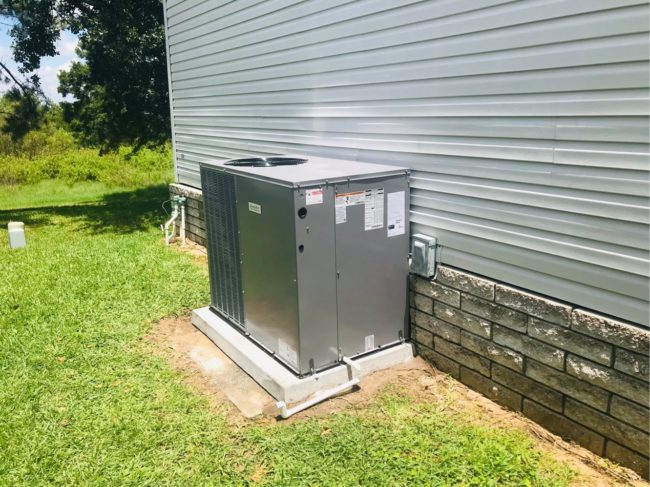
Fall days in Jacksonville can be both a blessing and a curse. While the temperatures might be going down, that famous Jacksonville humidity still rears its ugly head far too often. What do you do when it’s too cool to run your air conditioner but too humid to stay comfortable in your home? The good news is that your air conditioner may have a setting that’s specifically designed to deal with scenarios just like this called “dry mode.” If you want to learn more about dry mode and how to use it effectively in your home, check out this guide from the pros at McGowan's Heating & Air Conditioning.
What Is Dry Mode?
Dry mode is a setting on your air conditioner. You can access it using your thermostat like you would the “cool” or “heat” settings. When it’s active, dry mode runs the air conditioner at a low speed to circulate cold refrigerant through the air conditioner’s evaporator coil. As the blower fan pushes warm, humid air over the evaporator coil, some of the moisture in the air condenses on the evaporator coil. As more and more air circulates through the cooling chamber, the relative humidity in your home will begin to drop. Eventually, the levels will drop low enough that you’ll likely notice that the air feels cooler, even if the thermostat still senses the same temperature.
How Is Dry Mode Different Than Regular Cooling Mode?
The biggest difference between dry mode and cooling mode is the speed at which the system draws in the warm and humid air. In cooling mode, the blower fan and compressor are working at high speeds to move a lot of air and refrigerant through the air conditioner. Performing this process rapidly has the effect of drawing heat energy out of the air as it passes through the evaporator coil in addition to drawing out excess moisture. During dry-mode operation, the system slows everything down. The compressor will work at a slower speed so that refrigerant doesn’t flow through the evaporator coil as quickly as it does when the system is in cooling mode. This means that more heat energy remains in the air as it passes through the evaporator coil so that the air coming out of the system doesn’t change its temperature.
Do All Air Conditioners Have a Dry Mode?
While dry mode is a great feature to have on an air conditioner, the only systems that offer this feature are systems with a multi-speed compressor. Being able to slow down the compressor, and thereby the cooling process of the refrigerant, is the main way that an air conditioner can remove humidity without lowering the temperature of your home. Given the humid climate in Jacksonville, technicians at McGowan's Heating & Air Conditioning recommend variable-speed systems as often as possible. Although they are more expensive upfront, they have many benefits that make them well worth the cost.
How Long To Use Dry Mode
When using dry mode on your air conditioner, you’ll likely notice an immediate improvement in the overall comfort of your home. This noticeable difference in comfort makes many people prone to using dry mode for far too long. Although excess humidity isn’t something you want to deal with, removing too much moisture from your home’s indoor air can also be a problem. Since your air conditioner is an especially effective dehumidifier because it draws air from throughout your home, McGowan's Heating & Air Conditioning recommends that you run your air conditioner in dry mode for no more than two hours at a time. Any longer will likely result in low humidity levels that can cause dry skin, drywall cracking, poor indoor plant health, and other problems.
Benefits of Using Your AC’s Dry Setting
Beyond being able to remove humidity from the air on cool days, there are other benefits to using dry mode whenever you can. One benefit is that dry mode uses less electricity than the standard cooling mode. Since the entire system operates more slowly, the individual components will all draw less energy, resulting in savings on your utility bill. Furthermore, running the system slower tends to put less wear and tear on the system, meaning it may last longer than it would if you only had one speed to choose from. These dry-mode benefits apply to variable-speed systems even when you’re using the standard cooling mode. That’s because variable-speed air conditioners can sense the cooling load needed at any given time and adjust the operating speed of the system’s components as necessary.
Monitoring Your Home’s Humidity
Understanding how your home’s humidity levels change over time can help you fight high humidity more effectively. The best way to monitor humidity levels is to invest in a hygrometer. A hygrometer is an instrument that measures and displays the humidity levels in your home. Although there are countless types of hygrometers available, the most accurate models tend to be those that are designed to monitor the humidity levels in humidors, which are cases where cigars are stored. You can find hygrometers that can send humidity readings to your phone so that you never have to wonder about the comfort of your home.
Importance of Low Humidity
Keeping your home’s humidity levels under control is extremely important. Beyond the obvious importance of maintaining a comfortable home for your family, removing excess moisture from the air can also help to keep your family healthy. That’s because high humidity levels in a home can sometimes lead to mold growth. Since mold requires moisture to grow and thrive, providing moisture in the form of humidity is a recipe for disaster. Mold can grow just about anywhere, including on walls and ceilings, in air ducts, under floors, and anywhere else that has moisture and an organic food source for the mold. When mold proliferates, it can cause allergic reactions in family members with symptoms including sneezing, coughing, difficulty breathing, and much more. In other words, your air conditioner’s dry mode can literally be a lifesaver.
Fighting High Humidity
Beyond using dry mode, there are other ways that McGowan's Heating & Air Conditioning recommends to help you fight high humidity levels in your home. One step you can take is to deploy one or more portable dehumidifiers in problem areas around your home. While these units typically can’t remove as much moisture as an air conditioner, they can help combat high humidity levels to help avoid some of the consequences of chronic high humidity. You can also install a whole-home dehumidifier that works in conjunction with your air conditioner to ensure that your home is always at the perfect humidity level. Additionally, it’s a good idea to avoid leaving any standing water in your home that could evaporate and increase the humidity level. Finally, make sure that you keep your windows closed on humid days so that your system doesn’t have to work overtime to maintain your home’s comfort.
Florida HVAC Experts at McGowan’s Heating & Air Conditioning
At McGowan’s Heating & Air Conditioning, we encourage our customers to take charge of their home’s comfort in a variety of ways. That’s why we offer dehumidifier installation, humidity control assistance, air conditioner installation, furnace repair, and much more. We can also clean and repair ducts, install attic insulation, and design HVAC systems for new homes. For over 45 years, our commitment has always been to maintaining integrity and treating our customers with respect. This commitment is why you’ll find that we consistently receive five-star customer reviews. To learn more about controlling the humidity levels in your home, contact the HVAC professionals from McGowan’s Heating & Air Conditioning today.



